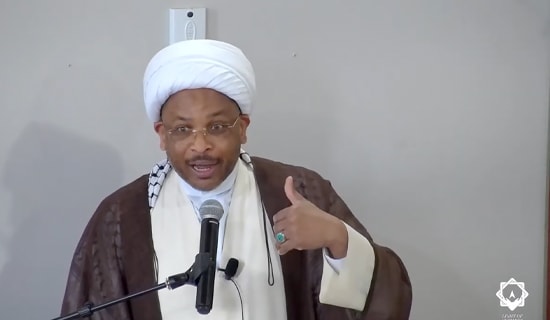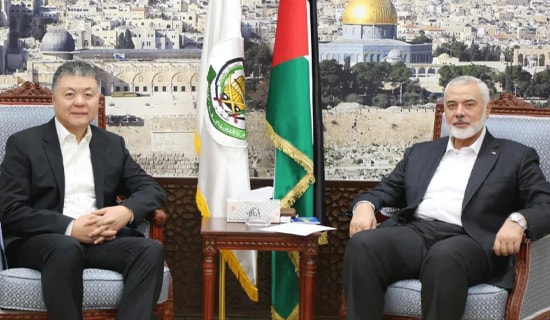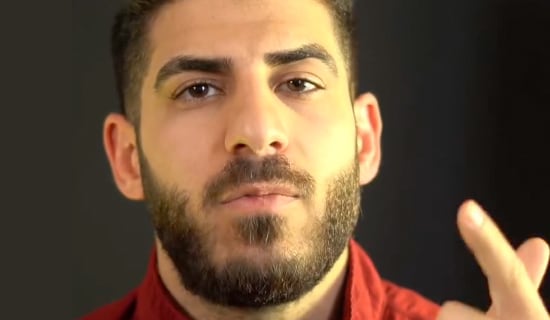Introduction – Arresting Opponents of the Iranian Regime
The student demonstrations that started in Tehran on June 10, 2003 spread across Iran and continued for 10 days. What began as a protest at the University of Tehran against the regime's intent to privatize university studies and charge tuition quickly broadened. Calls against regime heads and in support of democracy and regime change were voiced during the demonstrations, as were demands for the resignation of Iranian President Mohammad Khatami.[1]Although there was a period when it seemed that the regime had managed to suppress the unrest in Tehran , it erupted in other cities across the country.
The reaction of the conservative regime, which is accustomed to dealing with student demonstrations, was to try to contain them while at the same time restricting access to them by foreign media.[2]In official statements, the regime noted that student protests were legitimate, but at the same time acted harshly against the "hooligans," who, it said, had exploited the wave of unrest. The regime also made a show of preserving order. Following reports that forces of the Basij (the paramilitary youth militia loyal to the regime) and the Ansar-E Hizbullah (an organization loyal to the regime) had burst into student dormitories at the university and attacked students in their beds, and had attacked drivers who honked their horns in support of the demonstrators, the regime announced that a number of members of these organizations were arrested for attacking student demonstrators.[3]
Initially, the regime asserted that no students were detained. However, subsequently, Iranian Prosecutor-General Ayatollah Abd Al-Nabi Namazi announced that the regime had jailed 4,000 persons,[4]while Arab and foreign media sources reported on student disappearances and the arrests of intellectuals who spoke out against the regime.[5]
The London-based Arabic-language daily Al-Sharq Al-Awsatreported that Supreme Leader 'Ali Khamenei issued arrest warrants for 137 political activists, authors, and MPs, among them author and journalist Mohsen Sazgara, who posted pictures of the violent Ansar-E Hizbullah attack on sleeping students on his website. Also arrested was Taqi Rahmani, an author close to the recently banned Freedom Movement, and author Reza 'Alijani, who had previously spent over a year in solitary confinement while in prison.[6]
I. Reactions to the Regime's Attempts to Repress the Protests
A. Reformist Reactions
There was no uniform response by the reformist camp. Overall, the reformists expressed understanding of the student protests, but repeatedly called on the students to abide by the law or voice their arguments in subtler forums.
As in other crises, President Khatami was the only high-ranking political figure to hold off issuing a response, in this case, for 10 days. Khatami said that any criticism or opposition had to be within legal bounds, and added that "no [governmental] system supports disturbances or stubborn behavior by students," and that he expected the students to obey civil law.[7]
Defending and speaking for the students was Majlis (Parliament) Speaker Mehdi Karroubi, who countered claims by conservative religious leaders that only a few of the demonstrators were students[8]and defended them against conservative religious leaders who demanded that they be subject to the full force of the law. He said, "All the students you saw [in the demonstrations] are children of the revolution… They may have problems with a specific official, or with an institution, but they have no problem with the regime as a whole… Some were offended because their friends were arrested, but we, naturally, will solve this problem in accordance with the constitution. I do not use the terms 'thugs' and 'hooligans' [as the conservatives do with regard to the students]."[9]
Reformist officials cited the demonstrations as proof that the regime was free and democratic. Iranian President Mohammad Khatami said: "What differentiates democratic from non-democratic societies is the existence of demonstrations of this kind."[10]In his attempts to downplay the unrest, he said, "There is no news in Iran ; what is happening in Iran , like what happened in the past, is 100 times smaller than what happens in the U.S. every day. How can brutal treatment of the people by the American police be considered democratic, while non-violent demonstrations in Iran are glorified by the media?"[11]Foreign Ministry Spokesman Hamid Reza Assefi added, "It is natural that in a democratic country students call for their demands to be materialized. We are proud that we are living in a democratic country that derives its mandate from the people."[12]
Some reformists criticized the Basij and Ansar-E Hizbollah, calling them "thugs." Interior Minister Abdolvahed Moussavi-Lari, who also claimed that only some of the demonstrators were students, hinted that these organizations were responsible for the unrest, saying, "We were faced with two groups during the unrest. The first included those who did not observe the Islamic Republic boundaries and criteria and were inspired by foreign media to carry out destructive activities; the second group included vigilantes and irresponsible elements [i.e. Basijand Ansar-E Hizbollah] who acted without taking into account the country's interests."[13]
Moreover, a letter signed by 166 Majlis members decried "the brutal behavior towards the students" by the Basijand Ansar-E Hizbollah, but nonetheless warned students to be wary of suspicious elements infiltrating their ranks. The letter also stated that the demonstrations were the result of the absence of channels for criticism of the political system and of the regime's failure to pay attention to the people's democratic demands.[14]
Officials outside the government – such as high-ranking cleric Ayatollah Saneii and members of radical reformist groups in the Majlis – called for the government to address the students' demands regarding the suppression of free speech and the need for political reform. They also explicitly condemned the Ansar-E Hizbollah and Basij actions. Ayatollah Saneii said: "The greatest concern of the tyrants and oppressors is that the people have no connection to them… The people have [a right] to vote freely, in accordance with the constitution; the masses of the people must go to the polls."[15]
In addition, a member of Qom's Council of Theology Instructors, Hojjatoleslam Mohammad Taqi Fazel Meibodi, stated, "Assault, repression, and intimidation are not the way to deal with student and labor rallies [and have] almost always produced the opposite result." He called for the political parties and the free press to be reactivated so that they could speak for the students and workers; "if these bodies are institutionalized... we will not have such problems [i.e. street violence and clashes]."[16]
Al-Sharq Al-Awsat reported that 248 public figures, among them authors, intellectuals, and students, published an open letter emphasizing the Iranian people's right to criticize – or even remove – the regime leadership and to label absolute rule a form of heresy. The statement also said that the people "have the full right to supervise the actions of [their] leaders, to advise them, and to criticize them. The people also have a right to fire or topple them if they are dissatisfied with them… The status of figures [who place themselves] in a situation of absolute and divine rule is complete heresy towards God and a clear provocation to human dignity."[17]
The [Student] Office to Consolidate Unity issued a communiqué accusing the regime of tyranny and with acting against the aspirations of the people: "A government that breaks the mirror while looking at its ugly face in it – [a face reflected by] the criticism of detained writers and intellectuals – is not fit to run the country."[18]
Another facet of the reformist reaction to the student riots was to join the conservative camp in accusing the U.S. government and its leaders of responsibility for the demonstrations and of intervening in Iran's domestic affairs. Khatami, for example, called American declarations of support for the demonstrators "intervention in our domestic affairs," and 217 Majlis members signed a letter condemning the U.S. for "its intervention in Iran's domestic affairs affairs."[19]
B. Conservative Reactions
The conservatives condemned the demonstrations, describing the protesters as "hooligans" and "people incited by the foreign press." They accused the U.S. of involvement, whether through active assistance or through expressions of support. The conservatives repeatedly threatened to deal harshly and violently with the demonstrators; in actuality, however, the police tried not to be seen in the foreign press as forcibly repressing demonstrations, and restricted the demonstrations to campus grounds.[20]In addition, the conservatives took advantage of the event to attack reformist parliamentarians and to slander the entire student movement.
Immediately after the start of the unrest, Iran's Supreme Leader 'Ali Khamenei accused the U.S. of orchestrating the demonstrations and termed the demonstrators "emissaries of the enemy," saying: "The enemy openly supports these adventurers… Therefore, the entire people, especially youth and officials, must remain vigilant."[21]
At a ceremony marking the 1988 downing of an Iranian civilian airliner by a U.S. guided missile cruiser, former Iranian President Hashemi Rafsanjani, currently Expediency Council head, said: "Washington paid a heavy price in order to generate an atmosphere of unrest in our country… The unrest was led by a group of thugs and hooligans who thought a miracle was on the horizon… The failure of the recent unrest in Iran is a further disgrace to the U.S. – the dinosaur with the brain of a bird…"[22]
Tehran's Friday prayer leader and former Judiciary head Ayatollah Mohammad Yazdi added at Friday prayers, "There is no more room for patience towards those who endanger national security." He demanded that the students be declared enemies of Islam – a declaration that incurs a death sentence. In an attempt by the regime to prepare the ground for action against the student movement, Yazdi charged individuals who had acted on behalf of the movement with inciting the riots.[23]
SUPPORT OUR WORK

Tehran Police Chief Brig.-Gen. Morteza Talaie said that the troubles were caused by "those who once used to serve Saddam Hussein and America… and now are inciting people by means of television broadcasts funded by the Americans." Iran's Prosecutor-General Abd Al-Nabi Namazi promised that "the agents responsible for the riots… would be dealt with forcefully."[24]
Also, the Basij at Tehran Universityissued a statement saying that its "organized and lawful participation" in recent developments "had been at the request of [regime] officials, and was aimed at stopping the demonstrators' ploys."[25]
II. Majlis Members Accused of Involvement in Demonstrations
With the approach of July 9, 2003 , the fourth anniversary of the 1999 riots, a new crisis was fomenting between the regime and the reformist camp, based on the regime's accusations that reformist Majlis members were involved in the demonstrations. These charges came in reaction to some Majlis members (Mathim Sa'idi, Fateme Haqiqat Joo, Reza Yosefian, and Ali Akbar Mussavi Hoini) who declared a 48-hour sit-in protest against police treatment of students.[26]
Tehran Prosecutor-General Saeed Mortazavi , who has shut down over 80 newspapers during the past three years, said that the Judiciary would prosecute any MP found guilty of fanning the unrest.[27]The conservative Resalatand Kayhandailies published admissions by detained student Payman 'Aref regarding the involvement of MPs in the incidents.[28]
However, MP Haqiqat-Joo called the admissions by the detained student "funny and completely counter to the truth." She added that "the publication of such admissions is a phase in a scenario planned in advance and designed by the strategists of the tyranny and the aggression against the students… One of the objectives behind such moves is concealing the inhumane crimes committed against the students in the university dormitories… These confessions are virtually a piece in the puzzle that can be called 'suppression of Iran 's reform movement,' aimed at denying all the righteous demands of the Iranian nation, and therefore totally worthless and unauthentic."[29]
Also, the reformist daily Aftab-e Yazd stated that confessions by detained students that reformist MPs had urged the students to go out into the streets to demonstrate "should not be taken seriously." The paper claimed that those who were arrested were making false statements as a result of their difficult prison conditions and their lack of access to legal defense.[30]
The same MPs – Mathim Sa'idi, Fateme Haqiqat Joo, Reza Yosefian, and Ali Akbar Mussavi Hoini – wrote a letter to Revolutionary Guards Commander Maj.-Gen. Rahim Safavi urging him to prevent armed forces, including the Basij, from becoming involved in political matters such as student gatherings.[31]In response, Revolutionary Guards Spokesman Brig.-Gen. Massoud Jazayeri said that the Basij was a legitimate student body and was entitled to intervene in student-related affairs. He concluded by saying, "The Revolutionary Guards will continue to defend the lofty value system of the Islamic Revolution in the military, cultural, political, and social domains."[32]
*Ayelet Savyon is Director of the Iranian Media Project
[1]Aftab-e Yazd(Iran), June 12, 2003; Al-Hayat (London), June 12, 2003; Al-Sharq Al-Awsat (London), June 12, 2003.
[2]IRNA (Iran), June 16, 2003.
[3]One of these activists, Saeed 'Asgar, was suspected of involvement in an assassination attempt on high-ranking reformist Saeed Hajjarian, advisor to President Khatami, in 2000. Reformist MP and Deputy Chairman of the Parliamentary Committee on National Security and Foreign Policy Mohsen Armin called for a public, open trial of the detained Basij vigilantes (Yas-e No, July 7, 2003). See reports on the unrest: Aftab-e Yazd(Iran), June 12, 2003; Yas-e No (Iran), June 15, 2003; IRNA (Iran), June 18, 2003; Aftab-e Yazd(Iran), June 19, 2003.
[4]Kayhan (Iran), June 28, 2003. In contrast, Iranian Judiciary Spokesman Gholam Hossein Elham announced that the number of students arrested was less than 100, while the total number of detainees was about 1,000; IRNA (Iran), July 2, 2003.
[5]IRNA (Iran), June 15, 2003; Al-Sharq Al-Awsat (London) reported on June 26 that some 8,000 people were arrested in the rioting.
[6]Aftab-e Yazd (Iran) , June 16, 2003.
[7]Aftab-e Yazd(Iran), June 19, 2003. MP Fatemeh Haqiqat-Joo called on President Khatami "to act with more resolve for the release of the students, as the actions so far have been too few and the students expect more from Mr. Khatami… in light of the 22 million votes his popularity won among the students;" Yas-e No (Iran), June 29, 2003; Aftab-e Yazd (Iran), June 29, 2003; June 30, 2003. Al-Sharq Al-Awsat (London) reported that President Khatami threatened to resign if any of those recently arrested were to be executed, but this report did not appear in any other source; Al-Sharq Al-Awsat (London), June 26, 2003.
[8]Aftab-e Yazd (Iran) , June 16, 2003; June 23, 2003.
[9]Aftab-e Yazd (Iran) , June 23, 2003. In addition, Foreign Ministry Spokesman Hamid Reza Assefi said that the students had separated themselves from those who wanted to promote their aims by using uncivil means and who had sought to take advantage of the students' demands; IRNA (Iran), June 23, 2003.
[10]Aftab-e Yazd (Iran) , June 19, 2003.
[11]Mardomsalar (Iran), June 19, 2003.
[12]IRNA (Iran), June 23, 2003. Given the reports of 4,000 arrests connected with the unrest, the reformist daily Tose'especulated as to how many of those arrested by the police were plainclothes Basij. The newspaper stressed that it was precisely these plainclothes activists who were responsible for turning the student demonstrations into scenes of violence, and that Iranian citizens would like to see them brought to trial. Tose'e (Iran), July 2, 2003.
[13]IRNA (Iran), June 24, 2003.
[14]Aftab-e Yazd (Iran) , June 23, 2003.
[15]Aftab-e Yazd (Iran) , June 22, 2003.
[16]Iran Daily (Iran) , June 25, 2003.
[17]Al-Sharq Al-Awsat (London), June 16, 2003.
[18]Al-Sharq Al-Awsat (London), June 16, 2003.
[19]Mardomsalari (Iran) , Aftab-e Yazd (Iran) , June 19, 2003.
[20]Aftab-e Yazd (Iran) , June 22, 2003.
[21]Jomhouri-ye Eslami (Iran), June 14, 2003.
[22]Kayhan (Iran), July 2, 2003.
[23]Jomhouri-ye Eslami (Iran) , June 21, 2003.
[24]Jomhouri-ye Eslami (Iran), June 21, 2003.
[25]IRNA (Iran), June 19, 2003.
[26]Aftab-e Yazd(Iran), June 29, 2003.
[27]Kayhan (Iran), June 28, 2003
[28]Kayhan (Iran), Resalat (Iran), July 3, 2003.
[29]Yas-e No (Iran), July 5, 2003; Aftab-e Yazd (Iran), July 5, 2003; IRNA (Iran), July 4, 2003. Also, Secretary-General of the Islamic Iran Participation Front Muhammad Reza Khatami, the brother of President Khatami, published an open letter to President Khatami supporting Haqiqat-Joo's claims, and cautioning against pre-arranged confessions obtained through unlawful procedures for the propaganda campaign against political rights; IRNA (Iran), July 9, 2003.
[30]Aftab-e Yazd(Iran), July 6, 2003.
[31]IRNA (Iran), July 12, 2003.
[32]Iran Daily (Iran), July 14, 2003.




